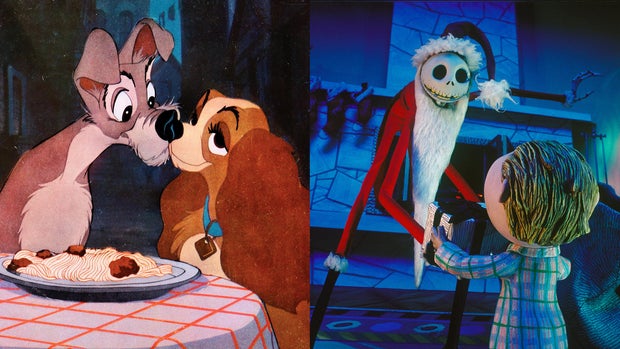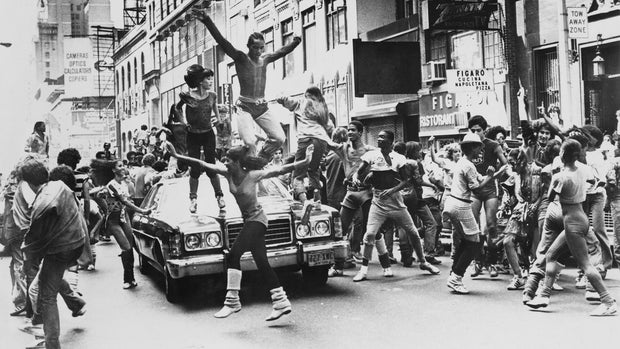The science-fiction classic “Terminator 2: Judgment Day,” starring Arnold Schwarzenegger as a cyborg from the future; “Apollo 13,” Ron Howard’s acclaimed dramatization of a catastrophic mission to the moon and NASA’s efforts to get the astronauts back alive; and “Home Alone,” a beloved Christmas comedy about a boy fending off a pair of bumbling burglars, are among the films named today to the Library of Congress’ National Film Registry, to be preserved for future generations.
Each year since 1989, 25 motion pictures are inducted into the Registry, chosen for their cultural, historic and aesthetic importance to America’s film heritage. Movies from all genres are included, after being nominated by filmmakers, academics, and film fans.
Other additions this year include the Disney animated feature “Lady and the Tramp” and Tim Burton’s stop-motion “The Nightmare Before Christmas”; the musical “Fame,” starring Irene Cara; “Desperately Seeking Susan,” a comedy starring Madonna and Rosanna Arquette; and John Sayles’ drama of union organizers in coal country, “Matewan.”
Also: “Bamboozled,” Spike Lee’s 2000 satire about television and racial stereotypes; Gina Prince-Bythewood’s romantic drama “Love & Basketball”; the 1933 ensemble comedy “Dinner at Eight,” based on the George S. Kaufman-Edna Ferber play; and “Edge of the City,” a drama starring Sidney Poitier and John Cassavetes that explored interracial friendships.
This year’s additions bring the total number of films in the Registry to 875 — the oldest being “A Movie Trip Through Filmland,” a short documentary from 1921 that shows how Kodak film stock is made; the most recent, from 2013, are the Oscar-winning documentary “20 Feet From Stardom,” a celebration of backup singers, and the Oscar-winner for best picture, “12 Years a Slave,” the true story of a free Black man in the 1840s who is kidnapped and sold into slavery.
“Films are an integral piece of America’s cultural heritage, reflecting stories of our nation for more than 125 years. We are proud to add 25 diverse films to the National Film Registry as we preserve our history through film,” said Librarian of Congress Carla Hayden.
On Thursday, December 14, at 8 p.m. ET, Turner Classic Movies will screen a selection of this year’s Registry additions. Select titles are also freely available online in the Library’s National Screening Room.
Below is a complete list of this year’s additions.
To submit nominations for films to be inducted in the Registry, click here.
Metro-Goldwyn-Mayer via Getty Images; 20th Century Fox; Sunset Boulevard/Corbis via Getty Images
Comedies
“Bamboozled” (2000) – Spike Lee’s satire about television and media stereotypes stars Damon Wayans as an African American TV executive who proposes a racist minstrel show featuring African American performers donning blackface. Instead of getting him fired, the show becomes a smash, while also inspiring violence by militant groups. With Savion Glover, Jada Pinkett Smith, Tommy Davidson, Mos Def, Michael Rapaport, and The Roots.
“Desperately Seeking Susan” (1985) – This screwball comedy about mistaken identity from director Susan Seidelman (“Smithereens”) stars Rosanna Arquette as a New Jersey housewife who becomes entranced with the doings of a free-spirit from New York’s Lower East Side, Susan (played by Madonna). A murder factors into the plot, but the film’s take on the city’s ’80s milieu, music and fashion keep it frothy.
“Dinner at Eight” (1933) – The pre-Code comedy/drama about a high society get-together features a stellar ensemble – Jean Harlow, John and Lionel Barrymore, Marie Dressler, Billie Burke and Wallace Beery, to name a few – orchestrated by director George Cukor. Frances Marion and Herman J. Mankiewicz adapted the George S. Kaufman-Edna Ferber play.
“Home Alone” (1990) – This endearing holiday mix of slapstick comedy from writer John Hughes and director Chris Columbus stars Macaulay Culkin as a young boy haphazardly left behind at Christmas time when his family rushes off for a European vacation, who must fend for himself when a pair of bumbling burglars (Joe Pesci, Daniel Stern) shows up at his house. With John Heard and Catherine O’Hara.
“The Wedding Banquet” (1993) – The second film of Ang Lee (“Brokeback Mountain,” “Crouching Tiger, Hidden Dragon”) is a ground-breaking romantic comedy about culture clashes in the Chinese-American community, as a gay Taiwanese immigrant in New York has a marriage of convenience with a woman from the Chinese mainland – and must present the bride to his visiting family.
LMPC, Touchstone Pictures/Sunset Boulevard/Corbis via Getty Images
Animation
“Lady and the Tramp” (1955) – One of the last from Disney’s classic era of animated features, this CinemaScope charmer tells the story of an unlikely romance between a pampered cocker spaniel and a homeless mutt. The cast featured singer Peggy Lee, who voiced Pekingese Peg, and also co-wrote six songs, such as “He’s a Tramp.” Decades later, Lee would win a multi-million lawsuit against Disney after the studio released the film on home video, with her songs, without her consent.
“The Nightmare Before Christmas” (1993) – Tim Burton (“Beetlejuice”) produced this stop-motion animated musical about the pumpkin-headed Jack Skellington, king of the monstrous denizens of Halloween Town, who plots to usurp Christmas. Directed by Henry Selick, with music by Danny Elfman, the voice cast includes Chris Sarandon, Catherine O’Hara, William Hickey, Ken Page, Paul Reubens and Glenn Shadix.
Universal Pictures via Getty Images; Searchlight Pictures; Tri-Star Pictures; Anarchist/Criterion Collection
Dramas
“Alambrista!” (1977) – Robert M. Young (“The Ballad of Gregorio Cortez”) directed this story of a Mexican migrant laborer, Roberto, who faces challenges in the United States (such as dodging immigration officials) as he works to earn money for his family back home.
“Apollo 13” (1995) – Ron Howard’s acclaimed dramatization of the near-tragic Apollo 13 flight, in which astronauts Jim Lovell, Jack Swigert and Fred Haise face a catastrophe in space, follows the efforts of both the lunar mission crew and NASA ground staff to get them back alive. With a top-notch cast (including Tom Hanks, Kevin Bacon, Bill Paxton, Gary Sinise, and Oscar-nominees Ed Harris and Kathleen Quinlan), the film was nominated for nine Academy Awards, including best picture, and won two (for film editing and sound).
“Edge of the City” (1957) – John Cassavetes and Sidney Poitier star in Martin Ritt’s first feature film, a character drama about an Army deserter who builds a friendship with a fellow dock worker in New York City. Featuring Ruby Dee, Kathleen Maguire and Jack Warden. The film was praised by the NAACP for its portrayal of interracial relationships.
“Love & Basketball” (2000) – Gina Prince-Bythewood’s directorial debut is a romantic drama about sports, in which a man and a woman’s shared love for basketball extends to each other.
“Matewan” (1987) – John Sayles dramatizes the bloody struggle facing coal miners in their efforts to unionize in 1920 West Virginia. The film stars Chris Cooper, James Earl Jones, Will Oldham, Mary McDonnell and David Straithairn, and features stunning, Oscar-nominated cinematography by Haskell Wexler.
“Terminator 2: Judgment Day” (1991) – Arnold Schwarzenegger had a hit playing a seemingly unstoppable killer robot from the future in James Cameron’s low-budget thriller “The Terminator.” Even though his cyborg was destroyed, bringing Schwarzenegger back for Cameron’s sequel wasn’t a problem – this was science fiction, after all – but the stakes were topped by having him confront an even more technologically-advanced killer robot from the future (played by Robert Patrick). With innovative computer-generated effects, and a stellar performance by Linda Hamilton as a badass revolutionary fighting an impending takeover of humanity by artificial intelligence, “T2” was a highpoint for the franchise, and set a very high bar for all other apocalyptic sci-fi films since.
“12 Years a Slave” (2013) – Winner of the Oscar for best picture, Steve McQueen’s dramatization of the memoir of Solomon Northup, a free African American who was kidnapped in the 1840s, transported to the South and sold into bondage, is a grueling story of inhumanity, and of one man’s struggle to regain his freedom. Featuring a strong cast (Chiwetel Ejiofor, Michael Fassbender, Benedict Cumberbatch, Paul Giamatti, Paul Dano, Sarah Paulson, Alfre Woodard and Brad Pitt, whose company produced the film), it also marked the screen debut of Lupita Nyong’o, who won the Oscar for best supporting actress for her performance as Patsey, an enslaved woman tormented by her owners.
United Artists/Getty Images
Musicals
“Fame” (1980) – Alan Parker’s ebullient musical about students at New York City’s High School of the Performing Arts stars Irene Cara (who was herself a former School of Performing Arts student, in the Music, Drama and Dance departments, but who was forced to drop out). Cara sings “Out Here on My Own,” “Hot Lunch Jam,” “I Sing the Body Electric,” and the title tune, which became a Top 10 hit and an Oscar-winner for Best Original Song. The movie put the school in the public consciousness, and while Parker was not allowed to film at the actual school building – the city’s Board of Education objected to the script – students made it into the film as background, including future dress designer Isaac Mizrahi, who was attending the school at the time. Student Laura Dean won the principal role of Lisa, a dancer. According to Parker, the dances in the film were designed to appear spontaneous and organic to the action rather than staged – “a sort of choreographed bedlam.”
“Passing Through” (1977) – Music is central to Larry Clark’s drama about an African American ex-con who explores the artistry of jazz through his musical mentors while rejecting corruption in the record industry. Featuring music by such artists as John Coltrane, Charlie Parker and Sun Ra. Rarely screened, “Passing Through” is not available in home video formats (as per the director’s wishes), but is nonetheless ranked among the top jazz films.
Radius
Documentaries
“Cruisin’ J-Town” (1975) – The political and cultural pulses of the 1960s and ’70s are explored by members of the jazz fusion band Hiroshima, whose music performed in the Little Tokyo section of Los Angeles shows the influences of the Asian American and Pacific Islander communities. From director Duane Kubo.
“Helen Keller in Her Story” (1954) – Nancy Hamilton won an Academy Award for her profile of the blind and deaf Keller, who became an advocate for disabled rights.
“Maya Lin: A Strong Clear Vision” (1994) – Freida Lee Mock’s documentary about the Chinese American artist and architect who, as a Yale student, won a nationwide design competition to create the new Vietnam Veterans Memorial on the National Mall. Lin’s stark and evocative design was attacked for being bleak and un-heroic, but today it stands as a cathartic testament to lives lost, and one of the most visited sites in Washington, D.C. Mock won the Oscar for best feature documentary.
“20 Feet from Stardom” (2013) – Morgan Neville’s Oscar-winning documentary explores the contributions, often anonymous or slighted, made by some of the most revered backup singers in the industry, including Darlene Love (who shared the stage with Dionne Warwick, Elvis Presley and Tom Jones); Merry Clayton (who sang with Ray Charles, Joe Cocker, Neil Diamond, Barbra Streisand and The Rolling Stones); Lisa Fischer (who sang with Luther Vandross and Mick Jagger); and Judith Hill (who sang duets with Stevie Wonder and Michael Jackson).
“We’re Alive” (1974) – Over the course of six months, Michie Gleason, Christine Lesiak and Kathy Levitt – three female UCLA graduate students – organized a video workshop featuring roundtable discussions by inmates at the then-largest women’s prison in the U.S., the California Institution for Women in Chino. The interviews, recorded by the inmates themselves, mixed condemnation of prison life and the difficulties (racism, economic disenfranchisement) facing them upon release with their own inherent dignity. The film was digitally restored by the UCLA Film & Television Archive, after the British Film Institute provided a 16mm print of the finished film.
Experimental/Short Films
Bohulano Family Film Collection (1950s-1970s) – Home movies have periodically been added to the Registry, both for their unfiltered depictions of American life, and as a nod to the democratic nature of motion picture technology. For more than 20 years Delfin Paderes Bohulano and Concepcion Moreno Bohulano used 8mm cameras to document their family life – births, graduations, marriages, baby showers, funerals – and the Filipino community in Stockton, California, as well as trips across the United States and overseas.
“The Lighted Field” (1987) – An avant-garde work by Andrew Noren, who created this hour-long abstraction of light and shadow, using found footage, some pulled from archives, and doctored images of nature and domesticity to comment on the passage of time.
“A Movie Trip Through Filmland” (1921) – Cameras take the audience to the headquarters of Eastman Kodak Company in Rochester, New York, to learn how motion picture film stock is made.
“Queen of Diamonds” (1991) –Feminist filmmaker Nina Menkes, noted for her poetic and surreal experimental films, collaborated with her frequent collaborator, her sister Tinka Menkes, who portrays a blackjack dealer and the alienation of her life in Las Vegas. Channeling Chantal Akerman, the film observes the desolation and loneliness of the city and surrounding desert, contrasted against the glaring nighttime views of the Strip. Recently restored by the Academy Film Archive and The Film Foundation, with funding provided by the George Lucas Family Foundation.
See also:




